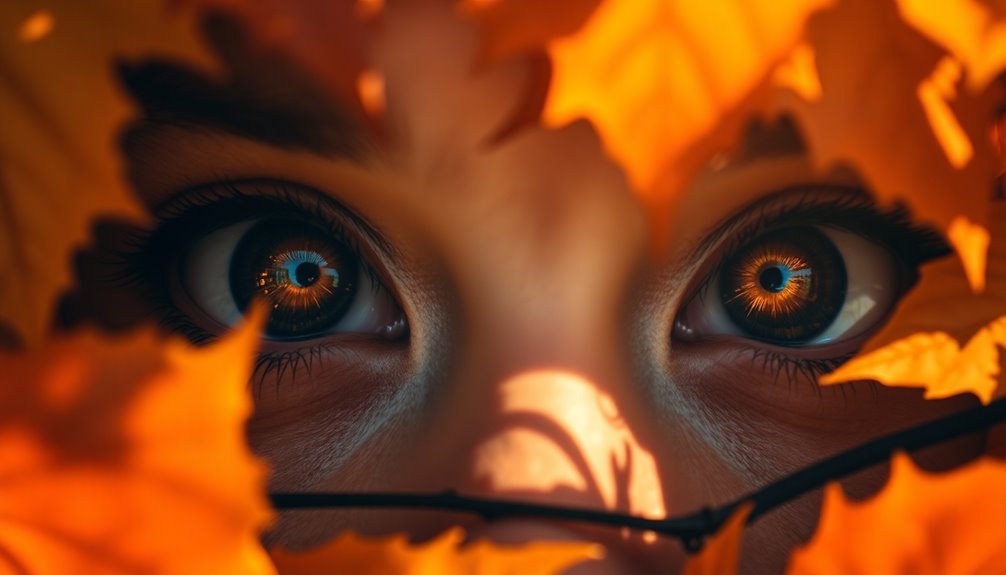You've got a world of options when it comes to symbolism! Colors can express deep feelings, like red for excitement and blue for calmness. Nature is full of symbols too—think roses for love or trees representing strength. Everyday objects can have meanings as well, like keys for opportunity or candles for hope. Cultural symbols vary, showing what different societies value, like the lotus flower for purity. In literature and art, symbols deepen stories and connect with emotions. It's all about exploring these meanings to find hidden treasures in your favorite stories and artworks! There's even more to discover!
Key Takeaways
- Colors can symbolize emotions and concepts, such as red for excitement and black for death.
- Nature elements like flowers, trees, and water represent various ideas, such as love, strength, and renewal.
- Everyday objects like keys, mirrors, and clocks convey deeper meanings related to access, self-reflection, and the passage of time.
- Cultural symbols vary across societies, like the lotus flower symbolizing purity in Eastern cultures and red representing luck in China.
- Historical symbols carry messages about life and identity, such as the lion for bravery and the olive branch for peace.
Understanding Symbolism

Symbolism plays an essential role in literature, offering layers of meaning that enhance your understanding of a narrative. When authors use symbolism, they pick objects, characters, or actions to stand for big ideas. Think of a heart representing love or a key symbolizing access. These symbols give stories depth.
Colors are also important in symbolism. For instance, black often stands for death, while white can mean purity. Red usually indicates passion or danger. But here's the catch: the meaning of symbols can change depending on the context. This means you'll need to pay attention to the cultural and historical settings of the story.
Understanding symbolism invites you to explore multiple interpretations. When you read, you might find joy in discovering what a rose means in one story compared to another. Each symbol can spark your imagination and connect you to the characters and themes.
Common Types of Symbols

Let's explore some common types of symbols you might see every day!
Colors can spark emotions, like how red can make you feel excited or alert.
Nature and everyday objects also tell stories, from the beauty of a rose to the meaning behind a simple key.
Color Symbolism in Art
Throughout history, colors have played an essential role in conveying emotions and ideas in art. You mightn't realize it, but color symbolism can make a huge difference in how we perceive a piece. For example, red often represents passion or danger, grabbing your attention right away!
Meanwhile, blue can bring feelings of tranquility and calmness, making you feel relaxed. Black is a color that symbolizes death or mourning, while white shines as a symbol of purity and new beginnings.
Isn't it interesting how different colors can represent such varied ideas? Green might evoke feelings of envy or growth, reminding you of nature's beauty. Yellow can bring a sense of optimism or even caution, depending on how it's used.
Don't forget about purple! It's often linked to royalty and spirituality, making it feel luxurious. Remember, symbols are often influenced by culture. For example, in some cultures, red is a sign of good fortune!
Nature as Symbolic Element
Colors aren't the only elements that convey deep meanings in art and literature; nature also plays a significant role as a symbolic element.
Think about flowers, for example. Different flowers have unique meanings. A rose represents love, while a lily symbolizes beauty and temptation. These flowers can add layers of emotion to a story or artwork.
Trees are another powerful symbol. They stand for growth, strength, and stability. When you see a family tree, it shows connections and lineage, reminding us of our roots and relationships. Isn't that beautiful?
Water, too, carries deep significance. It often represents life, fertility, and renewal. A river can symbolize freedom, but it might also represent challenges. In stories, characters might face a raging river, reflecting their struggles or obstacles.
These elements of nature enrich our understanding of art and literature. They connect us to feelings and ideas that words alone sometimes can't express.
Everyday Objects as Symbols**
Everyday objects often hold more than just their practical uses; they can carry profound symbolic meanings that enrich our understanding of the world. When you think about it, a simple key can represent access and opportunity. It's like revealing your potential!
Mirrors, too, are special. They symbolize self-reflection and truth, helping you dig deeper into your own identity and emotions.
Then there's the candle. It's not just for light; it symbolizes hope and enlightenment, shining bright even in dark times.
Books are another fantastic example. They symbolize knowledge and learning, reminding us how important education is in our everyday life.
And don't forget about clocks! They serve as a gentle reminder of time's passage and mortality, urging us to cherish every moment.
Each of these everyday objects carries unique symbolic meanings that can inspire you. By recognizing the use of symbolism in our daily lives, you can find deeper connections in the world around you. Exploring these meanings can be both exciting and enlightening!
Colors and Their Meanings

Exploring the world of symbolism, you'll find that colors convey powerful meanings and emotions. Each color has a meaning beyond its literal appearance, adding depth to our experiences.
For instance, red often symbolizes passion and love, but it can also signal danger and urgency. When you see red, it grabs your attention!
Black usually represents death or mourning, evoking feelings of mystery and despair. It's a color that can make stories more dramatic.
On the other hand, white is a beautiful symbol of purity. It's often used in weddings and ceremonies to represent new beginnings and innocence.
Then there's blue, which embodies tranquility and trust. It creates a calming atmosphere and makes you feel secure.
Finally, green symbolizes nature and growth. It reminds us of life and renewal, and it's closely linked to environmental themes.
Colors are more than just pretty shades; they each carry unique meanings that can shape our feelings.
Objects as Symbols

Objects around us can hold special meanings, and it's fun to explore what they symbolize! For example, a key might represent new opportunities, while a mirror can show us our true selves.
Different cultures also see objects in unique ways, like how the color red can mean both love and danger, making our discoveries even more exciting!
Everyday Objects' Meanings
In our daily lives, seemingly mundane items often carry deeper meanings that can shape our perceptions and experiences. These objects can become powerful symbols, helping us connect with universal themes. Let's explore some everyday items and their meanings!
| Object | Symbolism |
|---|---|
| Keys | Access and opportunity |
| Mirrors | Self-reflection and truth |
| Candles | Hope and enlightenment |
| Books | Knowledge and learning |
| Clocks | Passage of time and mortality |
Each of these objects has a special role in our lives. For instance, keys symbolize access and opportunity, representing the release of potential. Mirrors encourage self-reflection, allowing you to examine your identity. Candles light the way during dark times, filling you with hope. Books empower you with knowledge, opening new worlds and ideas. Finally, clocks remind you of life's fleeting nature, urging you to seize the moment.
Recognizing the symbolism in these everyday items can inspire you and help you navigate life's challenges. They represent courage, wisdom, and the chance for new beginnings, making your journey more meaningful!
Cultural Symbol Variations
Cultural symbols reveal fascinating variations in meaning across different societies, showcasing how the same object can evoke diverse interpretations.
For instance, the color white is commonly used to represent purity in Western cultures, but in places like China and India, it symbolizes mourning. Isn't that interesting?
Another example is the rose. You might know it as a symbol of love, but its meaning changes with color. Red roses signify romantic love, while yellow roses can represent friendship or even jealousy.
In Irish culture, the harp stands tall as a national symbol of pride and heritage. Meanwhile, in America, the eagle represents freedom and strength.
The lotus flower is cherished in Indian and Buddhist traditions for its symbolism of purity and enlightenment, yet in some Western contexts, it can also represent tranquility and peace.
Lastly, the crescent moon is a significant cultural symbol in Islam, signifying faith and spirituality. In Western societies, it often represents femininity and intuition.
These examples show how cultural symbols can represent something else entirely based on where you're in the world, making our understanding of them truly exciting!
Historical Symbols' Significance
Symbols throughout history have played a crucial role in shaping cultural identities and beliefs. They tell stories and convey important messages. Understanding historical symbols helps you appreciate their significance.
Here are four key symbols and their meanings:
- Lion: Often represents bravery and strength. In many cultures, it's linked to royalty.
- Ankh: This ancient Egyptian symbol looks like a cross with a loop. It represents eternal life, often found in tombs, reminding us of beliefs about the afterlife.
- Swastika: Originally a symbol of good fortune, it was misused by the Nazi Party. This change altered its meaning drastically in modern times.
- Olive Branch: Known for symbolizing peace, it dates back to ancient Greece. Victors in the Olympic Games were crowned with it, showing its long-standing importance.
Additionally, flags use colors to express values. For example, the color white often represents purity.
Historical symbols can also represent death, reminding us of life's fragility. By exploring these symbols, you can see how they connect to cultures and histories, making our world richer and more meaningful! Moreover, many Indigenous cultures use traditional healing practices as powerful symbols of their connection to the land and spirituality.
Nature and Symbolism
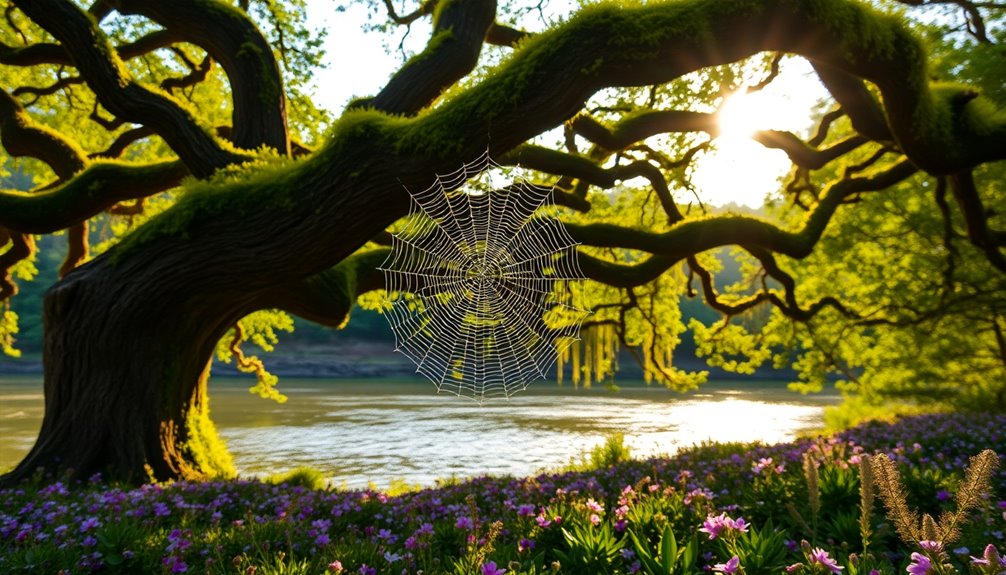
Throughout history, nature's elements have inspired countless symbols that resonate deeply within human experience. Nature often represents something else, conveying feelings and ideas that speak to our hearts.
For instance, flowers like roses and lilies symbolize romance and beauty, inviting you to explore their meanings.
The changing seasons also carry significant symbolism. Spring brings images of rebirth and renewal, while autumn reminds you of maturity and the passage of time.
Water, too, is a powerful symbol in nature. It represents life, fertility, and cleansing, often stirring emotions and evoking themes of renewal in stories.
Trees stand tall and symbolize strength, stability, and growth. Their roots connect to heritage and family, while branches reach out, signifying hopes and dreams.
Each element of nature is a treasure trove of symbols, inviting you to discover their hidden meanings.
Animals in Symbolism
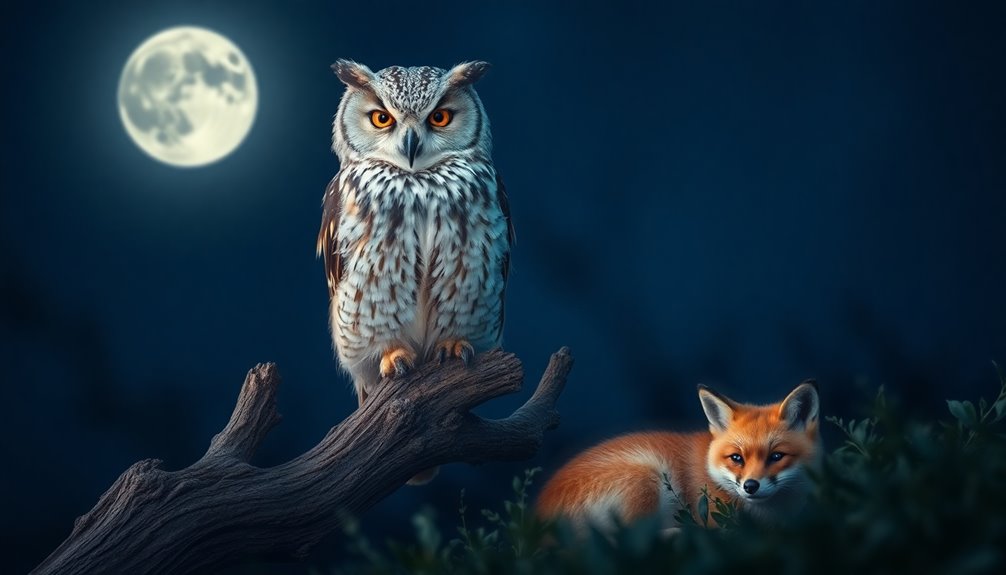
Animals hold special meanings in different cultures, and they often symbolize important ideas.
For example, a dove can represent peace, while a raven might signal something ominous.
Let's explore how these animal symbols vary across cultures and how they've inspired stories throughout literature!
Common Animal Symbols
When you immerse yourself in the world of symbolism, you'll find that various animals carry rich meanings across cultures.
These common animal symbols can help you understand deeper ideas and feelings. Here are a few fascinating examples:
- Ravens symbolize death and doom, often appearing in stories to warn of disaster.
- Doves represent peace and tranquility, making them popular in many religions and movements for harmony.
- Owls are symbols of wisdom and intelligence, believed to carry secrets and knowledge in various myths.
- Butterflies signify transformation and change, often seen as symbols of freedom and rebirth.
Cultural Variances in Animals
Many cultures attribute distinct meanings to the same animal, revealing the rich tapestry of symbolism that shapes our understanding of the world.
For instance, lions often symbolize courage and strength in many cultures. They're used to represent royalty and leadership, appearing in emblems and flags.
Owls, on the other hand, are widely seen as symbols of wisdom. Yet, in some cultures, they can represent death or bad omens, showing their dual nature.
Snakes are fascinating too! They symbolize rebirth and transformation because they shed their skin. However, in some places, like Judeo-Christian traditions, they're linked to danger and evil.
In different cultures, the crane is a symbol of longevity and good fortune in Japan, while in China, it represents wisdom and fidelity.
Elephants are revered across the globe, symbolizing strength in India and compassion in Africa.
These examples show how the same animal can evoke different meanings. As you explore symbolism, consider how these animals connect with values and beliefs in various cultures.
It's a wonderful way to appreciate our world's diversity!
Animal Symbolism in Literature
In literature, the symbolism of animals enriches narratives, offering deeper meanings and emotional resonance. Writers often use animals as symbols to convey complex ideas. Each creature can represent different themes, making stories more vivid and relatable.
Here are some common examples of animal symbolism:
- Ravens symbolize death and doom, often foreshadowing disaster. You might see this in Edgar Allan Poe's works.
- Doves are used as symbols of peace and tranquility, representing hope and harmony, especially in religious tales.
- Owls embody wisdom and knowledge. They often appear in stories that explore intelligence or mystery.
- Lions represent courage and strength, like Aslan in C.S. Lewis's "The Chronicles of Narnia," where he symbolizes bravery.
These animals not only add excitement to the story but also allow you to explore deeper meanings. By understanding animal symbolism, you can appreciate how writers connect themes and emotions.
Symbolism in Literature
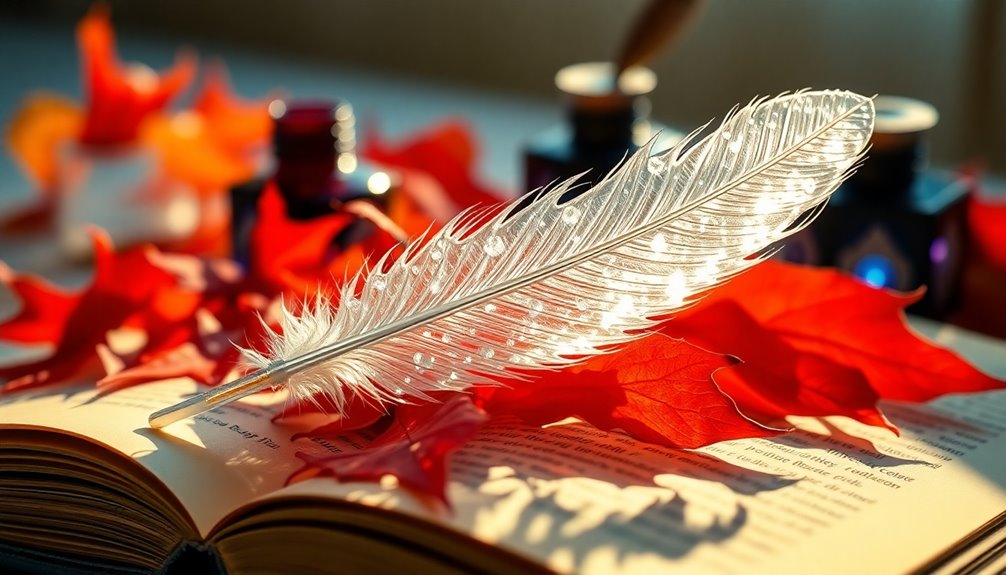
Symbolism in literature serves as a powerful tool that adds layers of meaning to narratives, engaging readers on multiple levels. When you use symbolism, you're opening doors to deeper understanding. For instance, the green light in "The Great Gatsby" symbolizes unattainable dreams. Similarly, in "Lord of the Flies," the conch shell represents civilization and order. Isn't that fascinating?
To help you explore this concept further, here's a quick reference table of examples:
| Symbol | Meaning |
|---|---|
| Green Light | Unattainable dreams |
| Conch Shell | Civilization and order |
| Scarlet Letter | Sin and guilt |
| Mockingbird | Innocence |
| Rose | Love and beauty |
Context of the story is essential when interpreting symbols. The author's intent and historical background can change how you see a symbol. By analyzing these symbols, you can uncover emotional responses they evoke and their cultural significance. So, next time you read, look for those symbols! You'll find that they bring the story to life in exciting ways.
Symbolism in Art
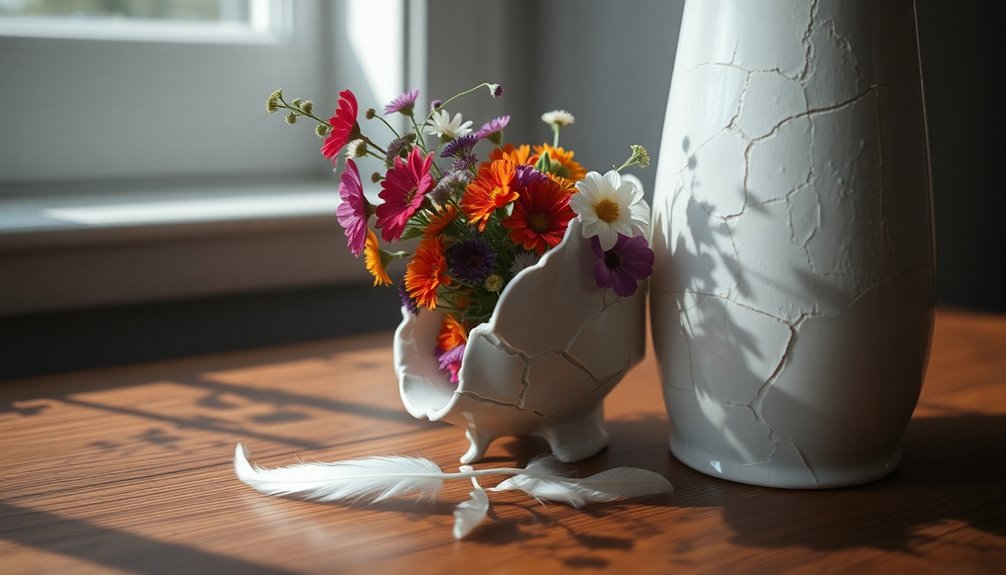
Art often speaks to us in ways that words cannot, utilizing symbolism to convey emotions and ideas. When you look at a painting, you might notice colors and objects that tell a story.
Here are some examples of how symbolism works in art:
- Color: Colors have meanings! For instance, red can symbolize passion, while blue often represents tranquility or sadness.
- Objects: Objects in art can carry deep meanings. A skull, for example, may symbolize mortality, reminding us of life's fleeting nature.
- Nature Imagery: Flowers and trees are powerful symbols too. Roses usually symbolize love, while lilies represent purity and innocence.
- Iconography: Artists often use recurring motifs, like doves for peace or snakes for temptation, to weave complex narratives across different cultures.
These symbols help you connect with the artwork on a personal level. When you understand the symbolism, you can feel the emotions and ideas the artist wanted to share.
Cultural Variations of Symbols
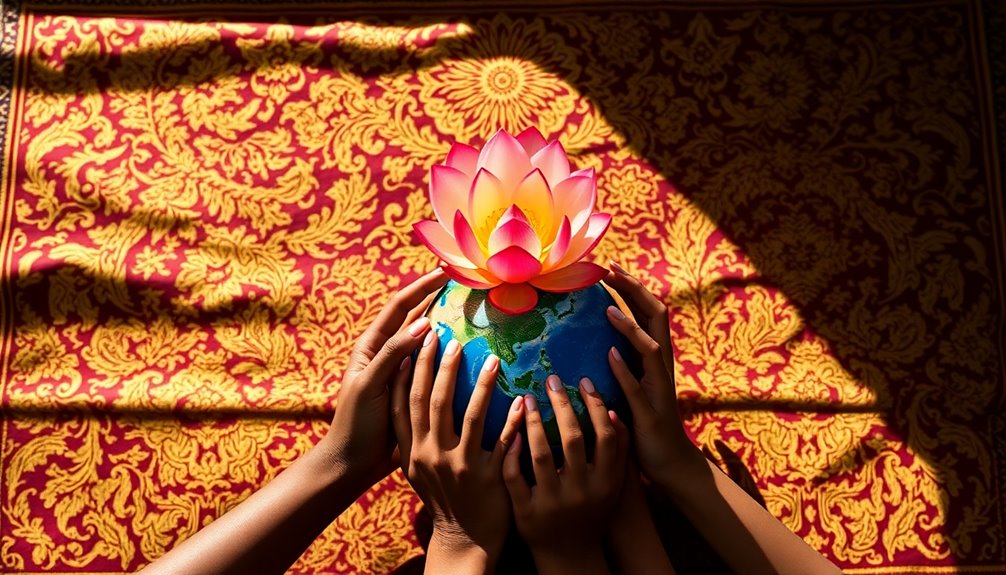
Understanding the meanings behind symbols can deepen your appreciation for different cultures. Symbols can change meaning based on where you are. For example, the color white is seen as pure in many Western cultures, but in some Asian cultures, it represents mourning. Isn't that fascinating?
Take the lotus flower. In Eastern religions, it stands for purity and enlightenment, while in Western settings, it might just mean beauty.
In Ireland, the harp is a symbol of national pride, but in ancient Greece, it's all about wisdom and the arts.
The crescent moon is another example. In Islam, it symbolizes faith and guidance, but in other cultures, it can represent femininity or fertility.
The color red is a great one too! In China, it brings luck and happiness, but in many Western places, it warns of danger.
These cultural variations of symbols show us that we can't rely on our preconceived notions alone. The symbolism used across different cultures can teach you so much about their values and beliefs.
Analyzing Symbolic Meanings

Symbols play an essential role in literature, providing layers of meaning that enhance the narrative. When you analyze symbolic meanings, you're diving deep into the heart of the story!
Here are some steps to help you understand better:
- Identify Recurring Symbols: Look for symbols that show up repeatedly. They often hold intended meanings that are important to the story.
- Consider Context: Think about the author's background and the time when the story was written. This can change how symbols are understood.
- Explore Emotional Impact: Reflect on how symbols affect characters and you as a reader. Do they create feelings of joy, sadness, or excitement?
- Research Significance: Learn about the cultural or historical background of symbols. This knowledge can enrich your understanding of their meanings.
Frequently Asked Questions
What Are Examples of Symbolism?
Symbolism is all around you!
Think about the mockingbird in "To Kill a Mockingbird"—it shows innocence and the idea that hurting the innocent is wrong.
Then, there's the green light in "The Great Gatsby," which represents dreams that seem out of reach.
The conch shell in "Lord of the Flies" stands for order and democracy.
Each of these examples helps you understand deeper meanings in stories, making them more exciting!
What Objects Can Be Symbolic?
Imagine walking through a magical forest, where every object tells a story. You might see a key, revealing mysteries and adventures.
A mirror reflects not just your face, but your true self.
A rose blooms, whispering secrets of love and friendship.
Chains might bind or connect, showing strength in unity.
And a ladder beckons, inviting you to climb toward your dreams.
Each object holds a special meaning, waiting for you to discover!
What Is Symbolism in Everyday Life?
Symbolism in everyday life is all around you! It's when objects, colors, or even actions represent deeper meanings.
For example, a heart often shows love, while a star can inspire hope. You might notice that flowers carry messages too; a rose symbolizes affection.
Even colors like red or blue can evoke specific feelings. By recognizing these symbols, you can better understand the world and the emotions behind different situations, making life even more interesting!
What Counts as Symbolism?
Did you know that colors can change how you feel? For example, red often stands for love or excitement.
When you think about symbolism, it's all about what things represent. Objects, like keys, can show opportunity, while animals, like doves, might symbolize peace.
Even everyday items can carry deeper meanings depending on their context. So, when you look around, remember that many things might be telling a story beyond their surface!
Conclusion
In the wonderful world of symbolism, you can discover hidden meanings everywhere! From colors that brighten your mood to objects that carry deep stories, each symbol adds a sprinkle of magic to our lives. As you explore literature and art, you'll find that these symbols can express feelings and ideas in a unique way. So, keep your eyes open and let your imagination soar! The joy of uncovering these treasures is truly delightful and always waiting for you!




